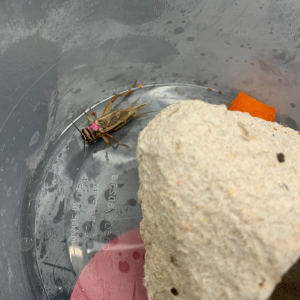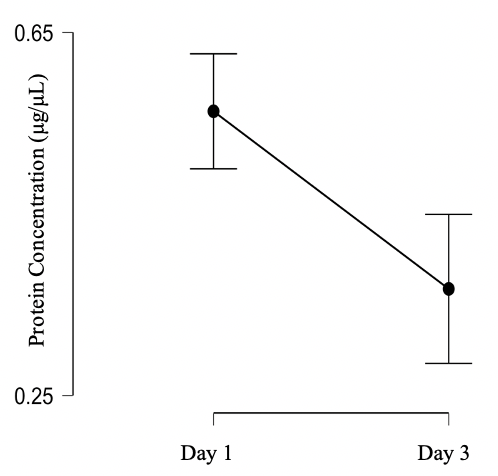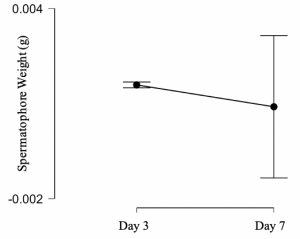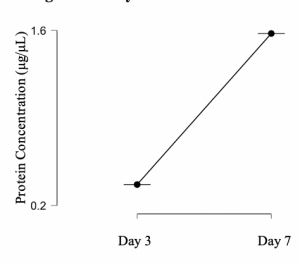9 The Effect of Temperature on Acheta domesticus’s Fecundity and Immunity
Arianna Buehler and Priyana Reddy

Getty Images/ Cricket Insect
Brief Background
- Higher temperatures yield optimal environments for enzymes, therefore, accelerating growth, development, and reproduction. Conversely, colder temperatures hinder these processes.
- Main point: Growth, development, and reproduction is directly proportionate to temperature
- Similarly, and immune challenge will compromise fecundity/reproduction
- However, some aspects of an immune response are heightened by temperature, while others are hindered by temperature
- We can predict the effect of temperature on reproduction, and the effect of an immune challenge on reproduction, however, we want to understand the COMBINED effect of temperature and an immune challenge on reproduction
- We predicted that heightened and lowered temperatures and an immune challenge would lower fecundity in crickets.
Research Question: How is fecundity affected by an immune challenge and/or temperature?
- Independent Variables: Temperature, Immune Challenge
- Dependent Variable: Fecundity
Methods
90 crickets were split into three temperature groups which represented a heat wave (33°C), ambient (28°C), and cold snap (20°C). On day one, crickets were weighed and checked for spermatophores; if present, spermatophores were removed, weighed, and seminal fluid protein concentration was assessed. (this served as a base line measurement). On day three, any present spermatophores were extracted, weighed and the protein concentration was measured (this gave us a measure of temperature’s effect on fecundity). In addition, on day 3 half of the crickets were given a shot of 10 μL of LPS which stimulated an immune response. On day seven, any present spermatophores are extracted, weighed and the protein concentration was measured (this final measurement served as the immune challenge’s effect combined with temperature)

Picture by Arianna Buehler
*To clarify: the data between days one and three portrayed the effect temperature had on the crickets and the data between days three and seven portrayed the compounded effect of temperature and an immune-challenge.*
Results
Temperature and Immunity Effect on Fecundity:
- The cold treatment crickets failed to produce spermatophores throughout the duration of the experiment
- By the third day of the experiment, the heat treatment spermatophores showed an increase in spermatophore weight, but a decrease in spermatophore protein concentration when compared to baseline measurements on Day 1 from the heat treatment group, though this difference was insignificant (t= -5.00, p= 0.063) (figures below)
- Spermatophores extracted from non-injected crickets in the heat treatment on Day 7 illustrated a decrease in spermatophore weight, but an increase in spermatophore protein concentration when compared to measurements taken on Day 3 from the heat treatment group, though these findings could not be analyzed since sample sizes were too small (figures below)




Temperature and Immunity Effect on Mortality:
- The heat treatment crickets had a significantly higher mortality rate than the control crickets (t=2.76, p= 0.005)
- The cold treatment crickets also experienced a significantly higher mortality rate than the control crickets (t=3.53 p=< 0.001)
- Cricket mortality was slightly higher in the cold treatment than the heat treatment, but the findings were insignificant (t=-.812, p= 0.423)
- Crickets in the heat and cold temperature treatments that were simultaneously immunocompromised experienced 100% mortality, while crickets in the control temperature treatment while simultaneously immunocompromised experienced a mortality rate of 54.54%
Interpretation/Significance
Temperature and Immunity Effect on Fecundity:
- Since the data for the heat treatment group fluctuated considerably from investment in spermatophore weight by day 3 (temperature’s effect) to investment in protein concentration by day 7 (still temperature’s effect, since spermatophores came from non-injected crickets), we were unable to draw any reliable conclusions (this is likely due to the small sample size). However, there appears to be an interaction between temperature and fecundity. With a larger sample size, this interaction would be much more clear.
- The lack of any production of spermatophores by the cold treatment is very clear of a relationship between temperature, immunity, and fecundity. This is clear because:
- a.) all crickets injected with 10 μL of lipopolysaccharides from Serratia marcescens died
- b.) no spermatophores were produced by the cold treatment group
Temperature and Immunity Effect on Mortality:
- We predicted that with higher temperatures comes greater and unavoidable investment in growth and development. Therefore, a bodily function, such as immunity, would be compromised. However, temperature may have been able to combat this trade-off because some immune functions are enhanced at warmer temperatures (i.e phenyloxidase activity), but all crickets injected with 10 μL of lipopolysaccharides from Serratia marcescens died. Therefore, the combined effect of an immune response and temperature does not affect fecundity, and in fact, illustrates a larger issue at play: increased mortality.
- We predicted that bodily functions have naturally slow due to colder temperatures, but, once again, temperature may be able to combat this as some immune functions are heightened at colder temperature (i.e melanization). However, our results show that the heightened mortality rate for the cold treatment group indicates that temperature and an immune challenge harm crickets because all crickets injected with 10 μL of lipopolysaccharides from Serratia marcescens died.
Further Applications
Our small set of data shows that temperature and immune challenges impact the fecundity and mortality of crickets. So, it is likely that other species that invest their reproductive and immune resources similarly to crickets will be impacted by temperature and immune challenges in a similar way to the crickets.
As the climate continues to shift, we expect to see shifting behaviors in these types of species. Both the heat wave and cold snap groups had higher mortality than the ambient temperature group, suggesting that the lifespan of crickets and other like species will be shorter as these weather phenomenas continue to occur more often and extreme.
Insects are important for pollination, so shorter lifespans will have a directly negative effect on plant reproduction. The death of individual plant and animals will lead to a decrease the amount of food in the local ecosystem. When there are less resources for an ecosystem, the carrying capacity diminishes, meaning that the amount of life that can be sustained in the area will be lower. More data needs to be collected on how the increase of heat waves and cold snaps will affect local ecosystems to verify if there is indeed a real threat to ecosystem collapse.
We hope our data will serve as a launching pad for other researchers to continue work in this important field.
Getty Images/Forest
Suggested Readings:
Adamo, Shelly A, and Maggie M. E. Lovett. “Some like It Hot: the Effects of Climate Change on Reproduction, Immune Function and Disease Resistance in the Cricket Gryllus Texensis.” Journal of Experimental Biology, vol. 214, 3 Mar. 2011, pp. 1997–2004., doi:10.1242/jeb.056531.

